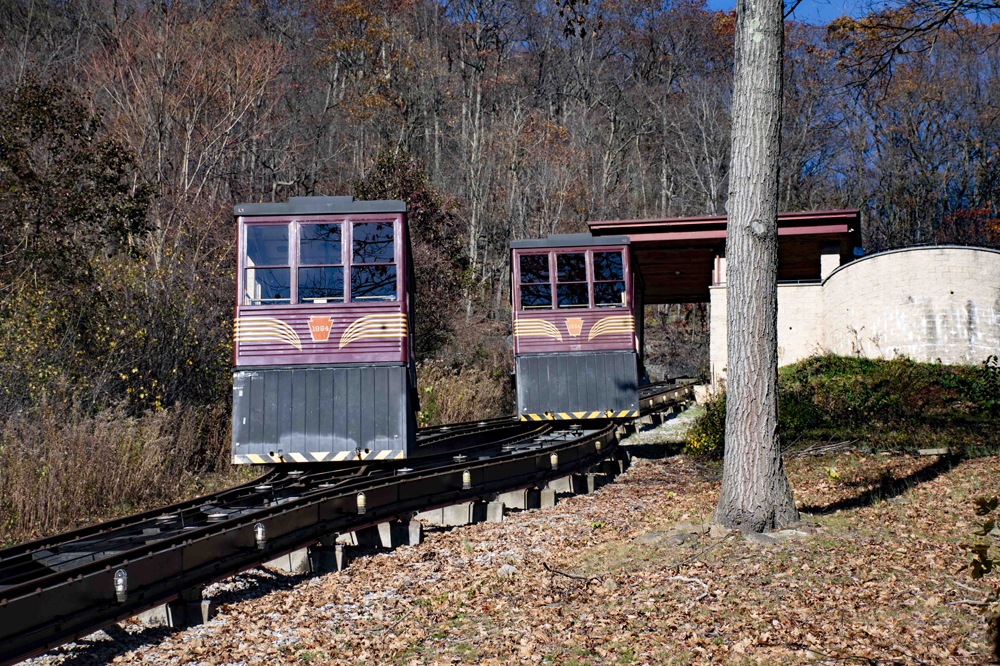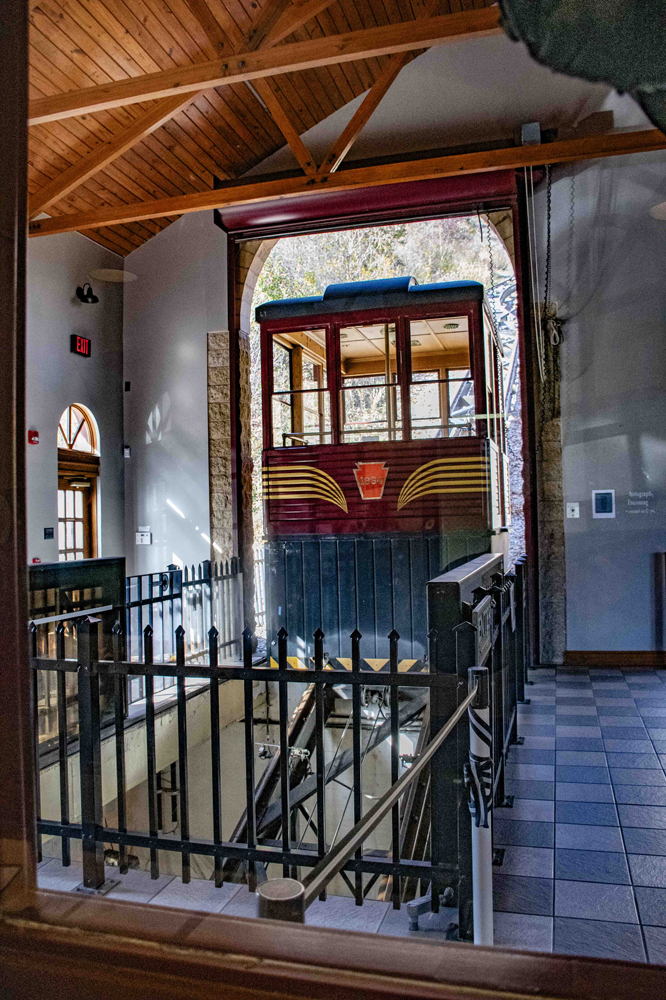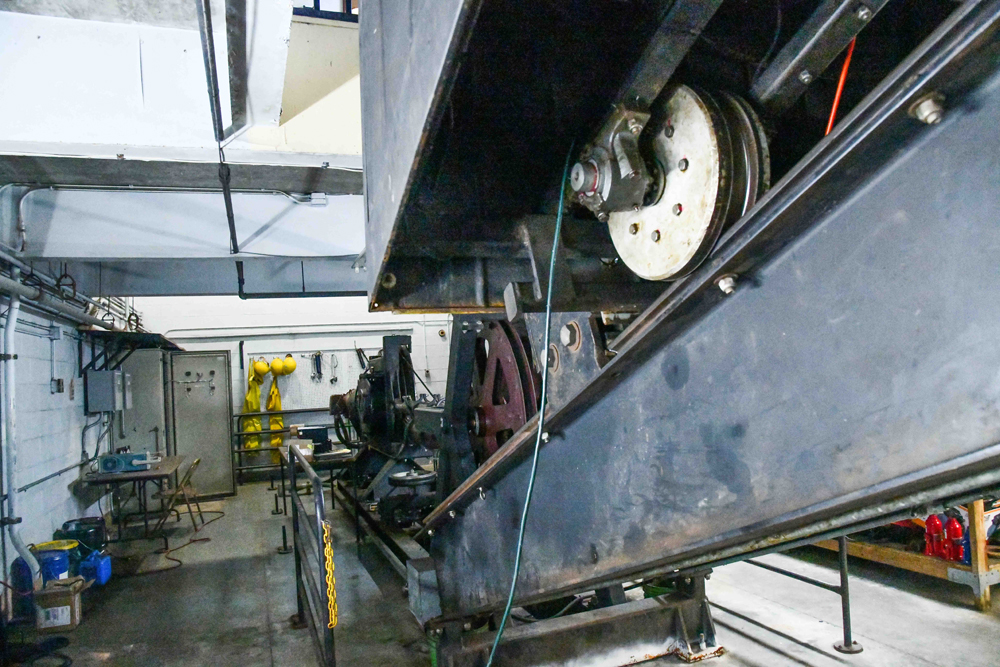
ALTOONA, Pa. – The trackside park at America’s oldest train-watching site – Horseshoe Curve, on Norfolk Southern’s Pittsburgh Line in west-central Pennsylvania – is again accessible to all visitors.
Closed since the end of the 2019 season by a seemingly endless cycle of mechanical, operational, electronic, and software issues, the funicular or inclined-plane railway that lifts patrons 10 stories from a visitor center to a track-level viewing area is again working as intended when it opened 32 years ago.
A final inspection by the Pennsylvania Department of Labor & Industry on Friday, Nov. 1, gave the all-clear to reopen the ride to the public, according to Joe DeFrancesco, executive director of the Railroaders Memorial Museum. The museum administers the site, situated five miles west of Altoona, from its main office downtown in the former Pennsylvania Railroad Master Mechanic’s Building.
During the shutdown, the combined sites attracted 30,000 visitors a year, with Horseshoe Curve being the greater draw by a 2-to-1 margin, DeFrancesco said. With the funicular reopened, he foresees visitation rising to 40,000 or 50,000. Over the nearly five-year period, the closure turned away thousands of visitors who wouldn’t or couldn’t climb the adjacent 194-step stairway, the equivalent of a 10-story building.

The ride no longer requires a separate token but is included with admission to the site, currently $13 for adults (a reduced rate was in effect during the closure). Discounts are available for youth, college students, senior citizens and military personnel. Admission is also available in a combination ticket with the downtown museum, or on an unlimited annual pass with a museum membership.
While the site began running the funicular since its “soft opening” last weekend, a formal reopening is planned for Saturday, Nov. 9, with a one-day special rate giving access to both attractions for $10. A Veteran’s Day event will take place at the downtown museum that day as well.
Seen from the park, the triple-track NS main line handles 50 or more freight and helper moves each day, plus Amtrak’s daily east- and westbound Pennsylvanian passenger train between Pittsburgh and New York.
Painted Tuscan Red with gold pinstripes to honor the passenger-car livery of the former PRR, the twin cabins carry 12 passengers each along a 270-foot-long track, ascending 99 feet in 2 minutes. One car rises as the other descends, with passing-track frogs at midpoint.
DeFrancesco said James “J.P.” Prough, facilities manager for the last three years, has been named to the new position of funicular supervisor, responsible for overseeing calibration, inspection, and maintenance.
“I’m deeply excited to be part of this,“ Prough said. “I’m thankful that it’s working. It’s been a long road.”
Site supervisor Teresa Feathers added, “With the [“funicular closed”] signs down, people are coming in; we’re not turning them away. It’s so great because it allows people to go up [to trackside] who were not able to go before,” including elderly and handicapped persons.
A custom-designed system
The railway was custom-built for the site by POMA of America, Inc., as part of the $5.8 million construction of the visitor center, opened in April 1992. Its two cabins were fabricated in the shops of the Durango & Silverton Narrow Gauge Railroad, and they worked well for 27 years.
As part of the overhaul, DeFrancesco said, the museum compiled a thick operator’s manual. Procedures were in place before, he said, but the combined needs of an aging system overwhelmed the organization’s ability to keep it running.
Contributing to a protracted delay were the COVID pandemic in 2020; technological advances that rendered the original equipment obsolete; the unique design that used few off-the-shelf replacement parts; and the hindrances of a supply chain that required parts from France, the Netherlands, and China.
In addition, the museum ran into obstacles finding current licensed engineers to certify both the mechanical side and the software governing propulsion and braking systems. At one point, the delay became so protracted that DeFrancesco and his board considered a stopgap of buying golf-cart-like vehicles to ferry visitors up a maintenance access road.
However, a volunteer at the Duquesne Incline in Pittsburgh referred the museum to two qualified firms that satisfied state-mandated safety rules, which, DeFrancesco said, “got it over the finish line.” He likened the technology to that of a ski lift.
The $150,000 cost of restoring service was shared equally by the museum and grants totaling $75,000 from the North American Railway Foundation, the charitable arm of the Brotherhood’s Relief and Compensation Fund. NARF also funded a facelift of the museum’s downtown event-space venue [See “New display, event space opens at Railroaders Memorial Museum,” Trains News Wire, April 18, 2024].
DeFrancesco said, “I’d also like to thank everybody who had a part in this – donors, staff, technicians, and the state.” L&I inspectors, he said, were supportive through the museum’s ordeal, having visited six or seven times during the shutdown. “They helped us in the process of learning to do it right,” he said.
“It’s a humbling reminder of why we do what we do,” he said. “It’s to share it with other people. We’re here to preserve railroad history but equally to serve the public. Seeing the reaction of people who come to see a beloved attraction is priceless.”
The funicular will operate through the rest of 2024 on a fall schedule of Fridays through Sundays, 9 a.m. to 4 p.m. As usual, the visitor center will close from January through March, when the combination of harsh weather — ice, sleet and deep snow — and mountainous terrain makes accommodating tourist visitation more difficult. During the break, the funicular will undergo scheduled maintenance and inspection.
— Updated at 7:05 a.m. CT with new information on admission prices, corrected title of funicular supervisor; updated Nov. 6 at 7:30 a.m. to correct number of steps to reach viewing area.















The correct spelling of the Curve’s name is “Horse Shoe Curve”; three words. Look it up.
Go figure, had to walk the stairs a couple of weeks ago, but explains why a guy was “hands on” the track pretty closely. Guess those few bucks I tossed in the jar helped.
They’re called “inclines” in Western PA. Johnstown has an incline that can take an automobile, and possibly a single truck streetcar in its day. Pittsburgh has two remaining inclines; one, the Monongahela Incline, is part of the transit system.
Phil Mulligan
I rode the funicular up when I last visited the HC in the summer of 2014.* They had trouble parking the car in place when it reached the top. Took a minute or two to do it and open the doors. I walked down (which I intended to do anyway) when I was done train watching.
My other HC visit was on a wet snowy day in November 1995.
My last three trips and stair count concur with 194 steps.
There probably should be an AED about half way up or down.
I thought there were 192 steps, per my visit in 2021. Web searches say 194 steps. The fourth paragraph reports 142 steps, which seems to be incorrect.